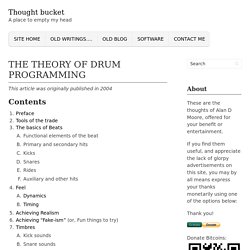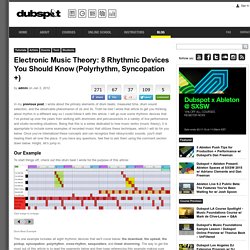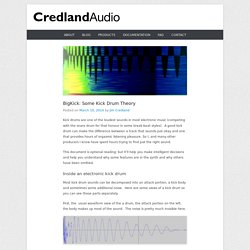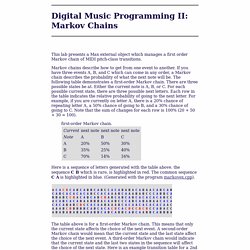

Beat Dissected - Attack Magazine. Drum programming - The Ultimate Guide to Programming Drums. Programming Drums: 8 Tips for Better Beats. Beat building is usually one of the first great loves, or one of the biggest obstacles to new electronic musicians. There’s a strange amount of insecurity, as there’s always the lingering thought that threatens us with, “Will they be able to tell that I’m not a real drummer…” and other such nonsense. Don’t listen to this voice! Instead, let me list a few tips for creating some programmed beats that may actually incite another voice to say, “Damn, you programmed that?” 1. Find the Right Tempo When building any beat, especially if you’re building from a beat you hear in your head, start with the right tempo. 2. Auto-Quantize can be either your most hated tool, or your best friend, depending on the style of drum pattern you are going for. 3. If you’re either programming, or recording your drums with a controller, I recommend building your drum patterns out from small looped sections and then building out, as the pattern sounds more to your liking. 4. 5. 6. 7. 8.
Conclusion. The Theory of Drum Programming. This article was originally published in 2004 PrefaceTools of the tradeThe basics of Beats Functional elements of the beat Primary and secondary hits Kicks Snares Rides Auxiliary and other hitsFeelAchieving RealismAchieving “Fake-ism” (or, Fun things to try)TimbresKick soundsSnare soundsHiHatsCymbalsDrum machines of noteAuxiliary percussionTips and other items of noteAppendix: resources on the web If you’ve found this article helpful, please make a small $2 donation via paypal by clicking the button.

Donation is optional, but very appreciated. It’s not much and it takes only a moment. Thanks for your help! Electronic Music Theory: 8 Rhythmic Devices You Should Know (Polyrhythm, Syncopation +) In my previous post, I wrote about the primary elements of drum beats: measured time, drum sound selection, and the observable phenomenon of 2s and 3s.

Truth be told I wrote that article to get you thinking about rhythm in a different way so I could follow it with this article. I will go over some rhythmic devices that I’ve picked up over the years from working with drummers and percussionists in a variety of live performance and studio recording situations. Being that this is a series dedicated to how music works (music theory), it is appropriate to include some examples of recorded music that utilizes these techniques, which I will do for you below. Once you’ve internalized these concepts and can recognize their idiosyncratic sounds, you’ll start hearing them all over the place.
If you have any questions, feel free to ask them using the comment section down below. BigKick: Some Kick Drum Theory. Kick drums are one of the loudest sounds in most electronic music (competing with the snare drum for that honour in some break-beat styles).

A good kick drum can make the difference between a track that sounds just okay and one that provides hours of orgasmic listening pleasure. So I, and many other producers I know have spent hours trying to find just the right sound. This document is optional reading: but it’ll help you make intelligent decisions and help you understand why some features are in the synth and why others have been omitted. Most kick drum sounds can be decomposed into an attack portion, a kick body and sometimes some additional noise. Dubstep for Beginners - Part 1: The Drums. With three equally important focal points, this tutorial series will initiate you each of these areas of dubstep and how to start producing your own grooves.

This first tutorial will focus around the drum beats and what makes the dubstep beats unique. LES 150 PLUS GRANDS BEATS HIP-HOP DE TOUS LES TEMPS. Hip-Hop 4 Life te dévoile ses « 150 PLUS GRANDS BEATS HIP-HOP DE TOUS LES TEMPS », une liste faite par un véritable passionné – MOI – qui va passer en revue l’ensemble de la culture Hip-Hop – Non, Ant et Kno ne passent pas en radio mais ça ne les empêchent pas de faire partie des meilleurs beatmakers du game -.

Ne vous étonnez donc pas de croiser des morceaux indés, le site n’ayant pas encore été corrompu par l’appât du gain – pas encore assez de visiteurs mais ça va venir ! -. Je t’offre 10 ans de culture Hip-Hop sur un plateau d’argent donc sois reconnaissant, dis merci à Papa, lâche un com’ et fais tourner le site à ceux qui aiment la bonne musique. Il y a quelques semaines, Complex lâchait son classement "The 100 Greatests Hip-Hop Beats of All Time", une liste faite par des journalistes octogénaires restés coincés dans les années 80 et citant BMF dans les meilleurs beats du 21ème siècle... Bien sûr la playlist associée est à kiffer ICI.
Collection Of Algorithmic Music Research Papers. Here is a Collection of 29 research papers on algorithmic music and conceptual design theory.

All these papers can be found freely on google but I thought a single resource collection would be valuable to though wanting to read more on the subject.. If have any Papers on this or similar topic and like them shared here please contact me and I be more that willing to share them with others. The Distance Geometry of Music Open Designs for Computer-Aided Algorithmic Music Composition Algorithmic prediction of music complexity judgements by Sebastian Streich, Perfecto Herrera Pompeu Fabra University, Barcelona, Spain Extra-Music(ologic)al Models for Algorithmic Composition. by A.C.Eldridge Algorithmic Composition: Computational Thinking in Music by Michael Edwards at the Reader in Music Technology School of Arts, Culture and Environment, University of Edinburgh in Edinburgh, UK. Digital Music Programming II: Markov Chains. This lab presents a Max external object which manages a first order Markov chain of MIDI pitch-class transitions.

Markov chains describe how to get from one event to another. If you have three events A, B, and C which can come in any order, a Markov chain describes the probability of what the next note will be. The following table demonstrates a first-order Markov chain. There are three possible states be at. Either the current note is A, B, or C. First-order Markov chain. Here is a sequence of letters generated with the table above. the sequence C B which is rare, is highlighted in red. The table above is for a first-order Markov chain. Second-order Markov chain. markov1.c Do exercise 1, and choose one of the following exercises to do. Effective Drum Programming, Part 1. How To Make Beats - The Best Guide Online - FREE!!